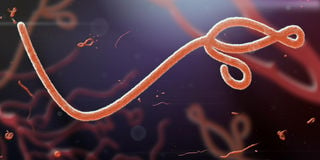Ebola virus disease (EVD): What it is and how you can protect yourself

What you need to know:
- The Ebola virus disease presents with symptoms similar to the flu, such as muscle and joint pain, sore throat, fever and headache.
- Additional symptoms include diarrhoea, vomiting and generalised internal and external bleeding.
- Wearing personal protective equipment around patients diagnosed with Ebola, as well as proper handwashing, goes a long way towards stemming the spread of this disease.
The Ebola virus disease (EVD) has often hit the Democratic Republic of Congo (DRC) with frequent outbreaks.
In March 2020, the DRC came close to being declared Ebola free after its last Ebola patient was discharged from hospital.
But on April 10, 2020, the World Health Organisation (WHO) announced that a new case of Ebola had been confirmed in Beni, north eastern DRC.
This viral disease docked in East Africa in September 2022 after a first case was reported in Uganda. The confirmed case was a 24-year-old male who was a resident at Ngabano village of Madudu Sub County in Mubende District.
He presented with Ebola symptoms and later died. Within four days, Ebola cases in Uganda increased to 16, with four confirmed deaths and 17 other fatalities suspected to be from this disease.
With Uganda next door to Kenya, you might be wondering what this disease is, how it spreads, and how you can protect yourself.
What is Ebola?
The Ebola virus disease (EVD) was formerly known as Ebola haemorrhagic fever. It is a severe illness that quickly becomes fatal. It spreads fast and often affects humans and other primates.
According to WHO, the Ebola virus disease has a case fatality of around 50 per cent. The disease spreads through human-to-human transmission via direct contact.
The Ebola virus is transmitted to people from wild animals such as fruit bats, porcupines and non-human primates. After this transmission, it then spreads in the human population through direct contact with the blood, secretions, organs or other bodily fluids of infected people, and with surfaces and materials - including beddings and clothing - that have been contaminated with these fluids.
“This happens through broken skin or mucous membranes with blood or body fluids of the sick or of patients who’ve died from Ebola, and objects that have been contaminated with body fluids from the sick or the dead from Ebola,” says WHO.
You can also get the Ebola virus through sexual contact with someone who is sick with the disease or who has recovered from it. This virus can persist in certain body fluids, including semen, even after recovery from the illness, posing a higher risk for transmission through sex.
Symptoms
The most common signs of Ebola are fever, aches, pains such as severe headache and muscle and joint pain; loss of appetite, sore throat, weakness and fatigue, unexplained haemorrhaging, unexplained bleeding or bruising, diarrhoea and vomiting, stomach pains, red eyes, skin rash, and hiccups.
The patient will not always show all of these signs or may show some or all of them. The CDC states that symptoms may appear to two to 21 days after the patient has had contact with the virus.
“Initially, symptoms will include fever, aches and pains, sore throat and fatigue. These will be joined by diarrhoea and vomiting as the virus manifests in the body,” the CDC states.
The WHO adds that the patient might also have symptoms of impaired kidney and liver function, internal and external bleeding - for example, oozing from the gums or blood in the stools.
“When a laboratory test is done, the patient might be found to be having low white blood cell and platelet counts, and elevated liver enzymes,” states the WHO.
Treatment
According to the CDC, there are two drugs approved by the American Food and Drug Administration (FDA) for the treatment of the Ebola virus disease.
“These are Inmazeb, which was approved in October 2020 and Ebanga, which was approved in December 2020,” the organisation says. The efficacy of these drugs was high during a randomised controlled trial conducted during the 2018 to 2020 Ebola outbreak in the DRC.
“Overall survival was much higher for patients receiving either of the two treatments prior to approval by the FDA,” the CDC states.
In addition, the WHO states that supportive care is also very critical in the management of a patient with Ebola virus disease. This involves rehydration with oral or intravenous fluids, and use of medications to treat symptoms, for example medication to support blood pressure, reduce vomiting and diarrhoea, and manage fever and pain.
There is also the Ervebo vaccine that was approved by the FDA in December 2020. This vaccine has also been prequalified by the WHO for use in persons aged 18 years of age and above. It is however not recommended for use in pregnant and breastfeeding women.
Who is at risk?
Health-care workers are at high risk of being infected with this virus disease because of their frequent contact with Ebola patients. However, this risk can be eliminated if health-care workers observe infection control precautions to the letter.
Recovering patients stay at risk of re-infection and can infect others as long as their blood still has the virus. Those who handle the body of a patient who succumbed to Ebola are also at risk.
“Burial ceremonies that involve direct contact with the body of the deceased are also a transmission risk for Ebola,” the WHO states.
Finally, a mother who is recovering from the Ebola virus should not breastfeed their baby without getting approval from a qualified health professional.
“Pregnant women who get acute Ebola and recover from the disease may still carry the virus in breast-milk, or in pregnancy related fluids and tissues,” cites the WHO. “However, women who become pregnant after surviving Ebola disease are not at risk of carrying the virus.”
Prevention
According to the WHO, proper hand washing is recommended for persons who visit patients at the hospitals and persons who attend to patients at home.
“Contact with body fluids should be avoided and washing with soap and water is recommended. Gloves and appropriate personal protective equipment should be worn when taking care of ill patients,” the WHO recommends.
The global health body also states that tracking and tracing of people who have been exposed to the virus should be high priority.
“Individuals who may have been in contact with an infected patient should be traced and monitored for 21 days,” cites the WHO.
To prevent transmission from patients to health workers, the WHO recommends that health-care workers always take standard precautions.
“These safety precautions include basic hand hygiene, respiratory hygiene, use of personal protective equipment to block splashes or other contact with infected materials, safe injection practices and safe burial practices,” the WHO says.


